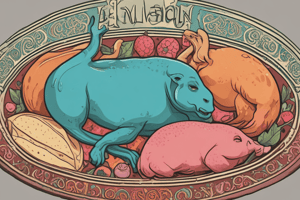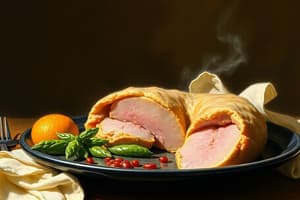Podcast
Questions and Answers
What is the maximum allowable alcohol content in food products for them to qualify as halal?
What is the maximum allowable alcohol content in food products for them to qualify as halal?
- 0.1%
- 0.5% (correct)
- 2%
- 1%
Which of the following statements is true regarding the use of fermented alcoholic drinks in food products?
Which of the following statements is true regarding the use of fermented alcoholic drinks in food products?
- As long as essence is extracted, their use is generally acceptable. (correct)
- Fermented alcoholic drinks can be added without restrictions.
- There are no guidelines on alcoholic drinks in halal food.
- Alcohol from these drinks is acceptable in any food product.
What is the requirement for the final alcohol content from industrial processes in food production?
What is the requirement for the final alcohol content from industrial processes in food production?
- It must be converted to acetic acid.
- It must always be greater than 0.5%.
- It can be higher than 1% if naturally produced.
- It should be less than 0.5%. (correct)
What happens if a food product contains more than 0.5% alcohol?
What happens if a food product contains more than 0.5% alcohol?
Which of the following is NOT accepted by halal-certifying agencies in food production?
Which of the following is NOT accepted by halal-certifying agencies in food production?
How do some countries' regulations differ regarding alcohol content in halal food?
How do some countries' regulations differ regarding alcohol content in halal food?
Why must the alcohol content be reduced to 0.5% in industrial food applications?
Why must the alcohol content be reduced to 0.5% in industrial food applications?
What is the guideline for naturally produced ethanol in food products according to halal standards?
What is the guideline for naturally produced ethanol in food products according to halal standards?
What is the key criterion for impurities in halal food production?
What is the key criterion for impurities in halal food production?
What is the ruling on consuming beverages produced with alcohol content derived from the process of making alcoholic drinks?
What is the ruling on consuming beverages produced with alcohol content derived from the process of making alcoholic drinks?
Which statement correctly describes the status of natural alcohol found in fruits or grains according to the ruling?
Which statement correctly describes the status of natural alcohol found in fruits or grains according to the ruling?
What is the ruling on foods or drinks containing flavors or colors derived from alcohol, if the alcohol was not produced via alcoholic fermentation?
What is the ruling on foods or drinks containing flavors or colors derived from alcohol, if the alcohol was not produced via alcoholic fermentation?
How is the ruling on medication or perfumes containing alcohol as a solvent classified?
How is the ruling on medication or perfumes containing alcohol as a solvent classified?
What determines whether a soft drink with an alcohol content under 1% v/v is permissible?
What determines whether a soft drink with an alcohol content under 1% v/v is permissible?
Flashcards are hidden until you start studying
Study Notes
Alcohol in the Quran
- Prohibition of alcohol occurred in three stages as revealed in the Quran.
- Initially highlighted that strong drink has great sin, outweighing its benefits (Chapter II, Verse 219).
- Muslims are instructed not to pray while intoxicated, indicating the importance of sobriety during worship (Chapter IV, Verse 43).
- Final command explicitly prohibits intoxicants and signifies their evil nature, urging believers to avoid them for spiritual success (Chapter V, Verse 90).
Alcohol in Food Industries
- Alcohol serves multiple roles: raw material for beverages, ingredient in foods, and solvent in various industries.
- Alcoholic beverages can legally contain between 0.5% to 80% ethyl alcohol; pure industrial alcohol can be up to 99%.
- Food products containing more than 7% alcohol are regulated by the Bureau of Alcohol, Tobacco, and Firearms (BATF), while the FDA oversees those with less.
- Alcohol must be labeled as an ingredient if included at over 0.5%, but not required if it's part of a flavoring ingredient.
Uses of Alcohol in Food Production
- As a solvent, alcohol extracts flavor from materials such as vanilla beans, with natural vanilla flavor requiring at least 35% alcohol by volume to meet FDA standards.
- Alcohol can additionally serve as a raw material, such as being converted to acetic acid for vinegar, making it halal.
- The process of chemical change (istihala) allows for the transformation of haram alcohol to halal vinegar.
Categories of Alcoholic Beverages
- Alcoholic beverages are classified into three major types:
- Fermented beverages from grains and fruits (3% to 16% alcohol).
- Distilled spirits, with alcohol content increased up to 80%.
- Compound or fortified beverages, created by mixing spirits with flavoring substances with high alcohol content.
- All types of alcoholic beverages are forbidden in Islam, along with any food or drinks made with them, such as spiked punch or brandy cakes.
Guidelines for Alcohol in Halal Food Production
- Natural products with intrinsic alcohol are generally acceptable.
- Industrial processes may allow alcohol use if viable alternatives are unavailable, but must ensure final products contain less than 0.5% alcohol.
- Alcohol from fermented beverages makes products haram unless distilled to negligible amounts or thoroughly evaporated.
- Halal certification requires products to not exceed 0.5% total alcohol, ensuring it is imperceptible in taste and smell to qualify as halal.
Alcohol in the Quran
- Prohibition of alcohol in the Quran occurs in three distinct stages, highlighting its gradual approach to banning.
- First mention emphasizes the greater sin of drinking alcohol over its utility (Quran 2:219).
- Subsequent verses instruct believers not to approach prayers while intoxicated (Quran 4:43), implying that regular prayer at specific times discourages alcohol consumption.
- Final clarification on alcohol's prohibition asserts that intoxicants are from Satan's handiwork, urging believers to avoid them for success (Quran 5:90-92).
- Consumption of alcoholic drinks is unambiguously prohibited, classifying them as najis (impure).
Alcohol in Food Industries
- Alcohol serves multiple roles including as a raw material, ingredient, and solvent in food, cosmetics, and pharmaceutical sectors.
- Alcoholic beverages can contain 0.5% to 80% ethyl alcohol, with pure industrial alcohol reaching 99%.
- When used as an ingredient, alcoholic food products must disclose specific beverages used if they contain more than 0.5% alcohol; those above 7% fall under Bureau of Alcohol, Tobacco, and Firearms (BATF) jurisdiction, while the FDA oversees those with less.
- Alcohol may also be utilized as a solvent for extracting flavors from natural sources, such as vanilla beans; natural vanilla flavoring must contain a minimum of 35% alcohol by volume as per FDA standards.
- Alcohol can be converted to acetic acid (vinegar), which is halal; this transformation principle is known as istihala (chemical change).
Categories of Alcoholic Beverages
- Alcoholic beverages are classified into three major categories:
- Fermented beverages: Containing 3-16% alcohol from agricultural products.
- Distilled beverages: Achieving alcohol content of up to 80% through distillation.
- Compound/fortified beverages: Resulting from the combination of fermented or spirit beverages with flavors, also exceeding 80% alcohol content.
- All alcoholic beverages are prohibited for Muslims, including those used in food preparation (e.g., branded cakes, spiked punches).
- Grain or synthetic alcohol may be acceptable in food production only if evaporated to 0.5% or lower.
Guidelines for Alcohol in Halal Food Production
- Natural products with intrinsic low levels of alcohol are generally not problematic for halal compliance.
- Islamic ruling states that alcohol derived from the fermentation process is haram and najis, while other non-intoxicating forms (<1% alcohol) can be permissible.
- Foods containing natural alcohols from fruits or grains during production are allowed.
- Flavoring and coloring agents with alcohol are permissible if not derived from the fermentation of alcohol and below 0.5% concentration.
- Medications and perfumes containing alcohol as solvents are permissible if not sourced from alcoholic production.
Studying That Suits You
Use AI to generate personalized quizzes and flashcards to suit your learning preferences.




